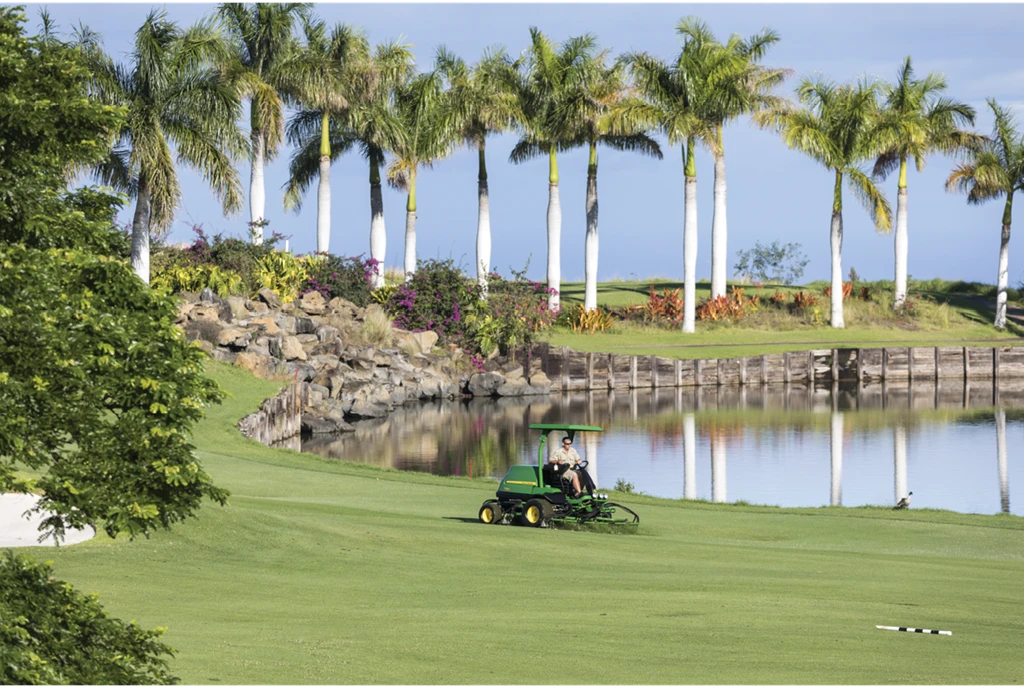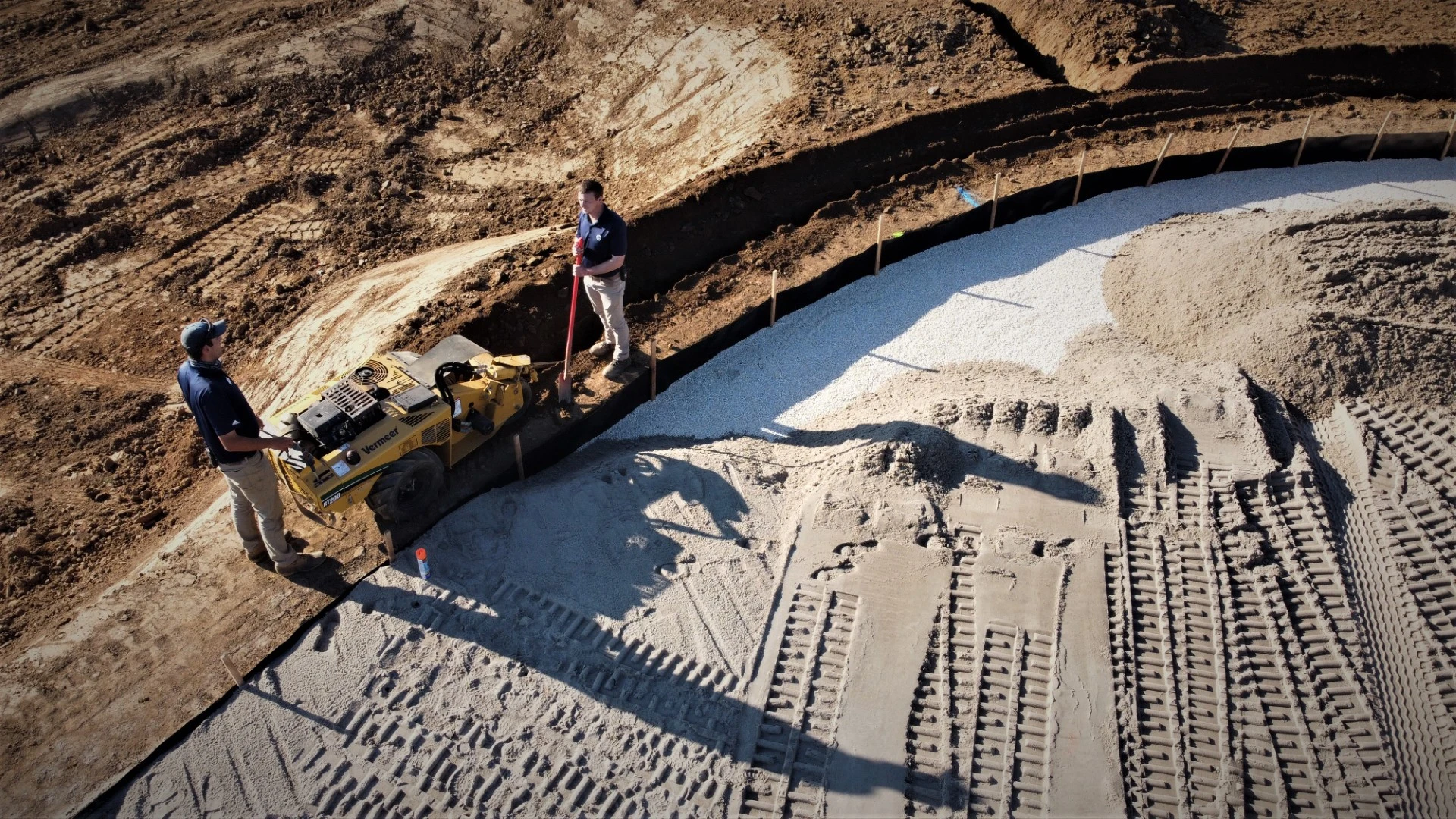

Plenty goes awry throughout the days, weeks and months maintaining a golf course. Normalcy, in most cases, reemerges without deep thought. On the mainland, distributors, suppliers, researchers and colleagues hustle to help superintendents endure tenuous stretches. Proximity allows golf to march along.
On land surrounded by water, such as Hawaii’s Big Island, the industry hustle requires careful coordination, constant communication and enough advanced plotting to make professional wedding planners envious. Kokua, the Hawaiian term for help, isn’t just a soothing concept offering speakers pleasant prose at industry conferences. It’s a multi-faceted necessity to keep golf viable.
Think about the equipment and supplies needed to separate golf from other recreational pursuits. Mowers, grinders, reels, rollers, rakes, sand, trimmers, chainsaws, blowers, chemicals, fertilizer, growth regulators, course accessories. Good luck finding any of the above materials manufactured in Hawaii.
The only homegrown resource on the Big Island are people. Even the most determined natives can’t provide conditions justifying three-figure green fees and five- and six-figure club initiations without kokua. Kailua-Kona, the epicenter of the golf activity on the Big Island, is one, two and sometimes three plane rides – and multiple train and boat stops – from industry hubs.
That was one thing for me coming out here, trying to anticipate what the challenges would be. Service and suppliers are a big part of this business, and I was very pleased with the amount of support that we have out here.” — Luke Bennett
“Logistically there are always going to be problems living on an island,” says Dan Husek, the director of golf course maintenance at Four Seasons Resorts Hualalai. “Things aren’t going to show up the next day, but you learn to live with it, you learn to adapt, you learn to take the answer four to six weeks and think, ‘OK, we might have to change plans, or we might have to adapt if the product is not going to be here.’”
Husek, who oversees the maintenance of two high-end golf courses, including one that hosts the PGA Tour Champions Mitsubishi Electric Championship at Hualalai, has a large color-coded, single-sided calendar resting behind his desk. The calendar titled, “Golf Maintenance Projects – 2018,” is a scripted agronomic plan. Before a year begins, Husek’s team knows the exact weeks it will be applying fertilizer or executing cultural practices.
Scott Main, the director of golf course maintenance at neighboring Nanea Golf Club, tries to think “a year to 18 months” ahead when plotting agronomic programs and projects. But completing a year according to a script represents agronomic utopia. Odd stuff happens on golf courses, including ones situated in paradise.

Some solutions are closer than others. Warehouses on the island might store a common pesticide, a same-day convenience to help a course when a spray falls a few gallons shortage of full coverage. A warehouse might also have a few bags of fertilizer and irrigation parts.
“We have an extremely strong relationship with all of the key vendors,” Kohanaiki superintendent Luke Bennett says. “I can go right across the street and our irrigation vendor is there, our fertilizer supplier is there. In fact, we have three irrigation suppliers across the street.”
Still, the warehousing and shipping hub of Hawaii is Oahu, the most populated of the state’s eight islands. Nearly every product used on a Big Island golf course will stop in Oahu during the distribution cycle.
Shipping challenges are the reason Kona Country Club superintendent Derrick Watts refers to sand as “white gold.” Enacted in 1920, 39 years before Hawaii became the 50th state, the Jones Act requires all goods shipped between U.S. ports to be U.S. vessels operated by at least 75 percent Americans. Less than 100 vessels comply with the act, according to the Grassroot Institute of Hawaii.
The act limits sand options for golf courses to varieties originating from South Pacific shipped via Oahu, where it is stockpiled, Main says. Costs exceed $200 per ton. Strong winds make it difficult – and expensive – for coastal courses to keep bunkers at playable depths. “If you’re spilling it,” Watts says, “you’re spilling $5 worth every spill.”
Main, who spent three years at Mauna Kea Resort, a 36-hole facility along the Pacific Ocean before arriving at Nanea last December, stuns mainland colleagues when describing the sand situation. Hawaii has no naturally produced silica sand and shipping costs have increased by around $100 in the last decade.
“When I was at the Golf Industry Show, people were like, ‘You have beaches everywhere. Sand must be easy,’” Main says. “But all of our sand comes from Vietnam. At Mauna Kea, if I wanted sand, I needed at least two weeks lead time. There’s no (golf) sand on this island. It’s all shipped from Oahu. They ship it in containers and you only get 20 to 22 tons at a time and it comes dried.
“We’re paying about, on average, $230 a ton for sand. That’s a lot different than most guys who are paying $60 to $80 a ton. When you aerify and bring in three or four loads, it’s $20,000 just to aerify. When I was at Mauna Kea, it’s a wind tunnel out there. We would have weeks of 30- to 70-plus mile per hour winds and it would cost you $80,000 to $100,000 just to get sand back in the bunkers.”
Equipment presents another conundrum. Abundant sun and comfortable temperatures produce a year-round growing environment. Aggressive turfgrasses such as Bermudagrass and paspalum and high salinity levels further tax mowers.
Mowers are used nearly every day to maintain Kona Country Club’s Bermudagrass surfaces. The hours add up so fast that Watts, according to his calculations, says three years of operating a mower – the length of the typical equipment lease on the Big Island – is akin to putting more than 280,000 miles on a car. “Would you want to keep that car?” Watts says. “Or would you want to trade in your Mercedes-Benz for a new car?”

Kokua, though, isn’t as far as it geographically appears. Watts says the equipment distributors who cover the island employee “really good mechanics.” Kona Country Club acquired a John Deere fleet before it reopened in 2016 following a major renovation. A mechanic from Pacific Golf & Turf, which has an Oahu location, visits Kona Country Club and other customers each week.
To provide additional kokua as its Big Island presence expands, John Deere has implemented a parts onsite program. High-moving parts such as bedknives, filters and tires are stored in onsite lockers and facilities are billed for what they use. The program prevents courses from putting a mower out of operation for multiple days while a part is shipped.
Parts that aren’t stored onsite can reach the island as fast as two days, says sales manager John O’Leary, whose territory includes Hawaii. Technology, including the OnEquip system, which integrates fleet data into John Deere’s OnLink platform, has the potential to expedite the diagnosis and recovery process, O’Leary adds.
Significant support networks and investments by industry companies comfort superintendents working in a remote location for the first time. “That was one thing for me coming out here, trying to anticipate what the challenges would be,” Bennett says. “Service and suppliers are a big part of this business, and I was very pleased with the amount of support that we have out here.”
A welcoming culture among superintendents supplements the support. The Big Island Golf Course Superintendents Association has shifted its focus from providing education to bringing all segments of the industry together for laidback events that establish personal relationships, says Bennett, the group’s vice president. Rounds of golf, fishing expeditions and meals create camaraderie among superintendents, assistants, technicians and foremen.
The relationships are invaluable when the turf doesn’t look right – and the needed researcher or product is an ocean away.
“The Big Island is unique,” says Husek, an Illinois native who also has worked on Guam. “I feel extraordinary about calling any of the fellow superintendents and asking, ‘What are you doing about this? What are you doing about that? Hey, would you come down and look at my greens?’ Let’s go play some golf. Let’s talk about what you’re doing vs. what I’m doing.’ There’s not a sense of competition as much as support.”
The help extends away from the course. “It’s not just the professional side,” he adds. “If somebody needed to move homes, I guarantee people would say, ‘I got a truck. I’ll come up and help you out.’”
Latest from Golf Course Industry
- Standard Golf announces new product lineup for 2025
- The Salt Pond taps Troon for management
- KemperSports selected to manage Swansea Country Club
- From the publisher’s pen: Grab that guide
- Introducing our April 2025 issue
- South Carolina leaders honor golf course superintendent
- One and only
- Wild can be good







